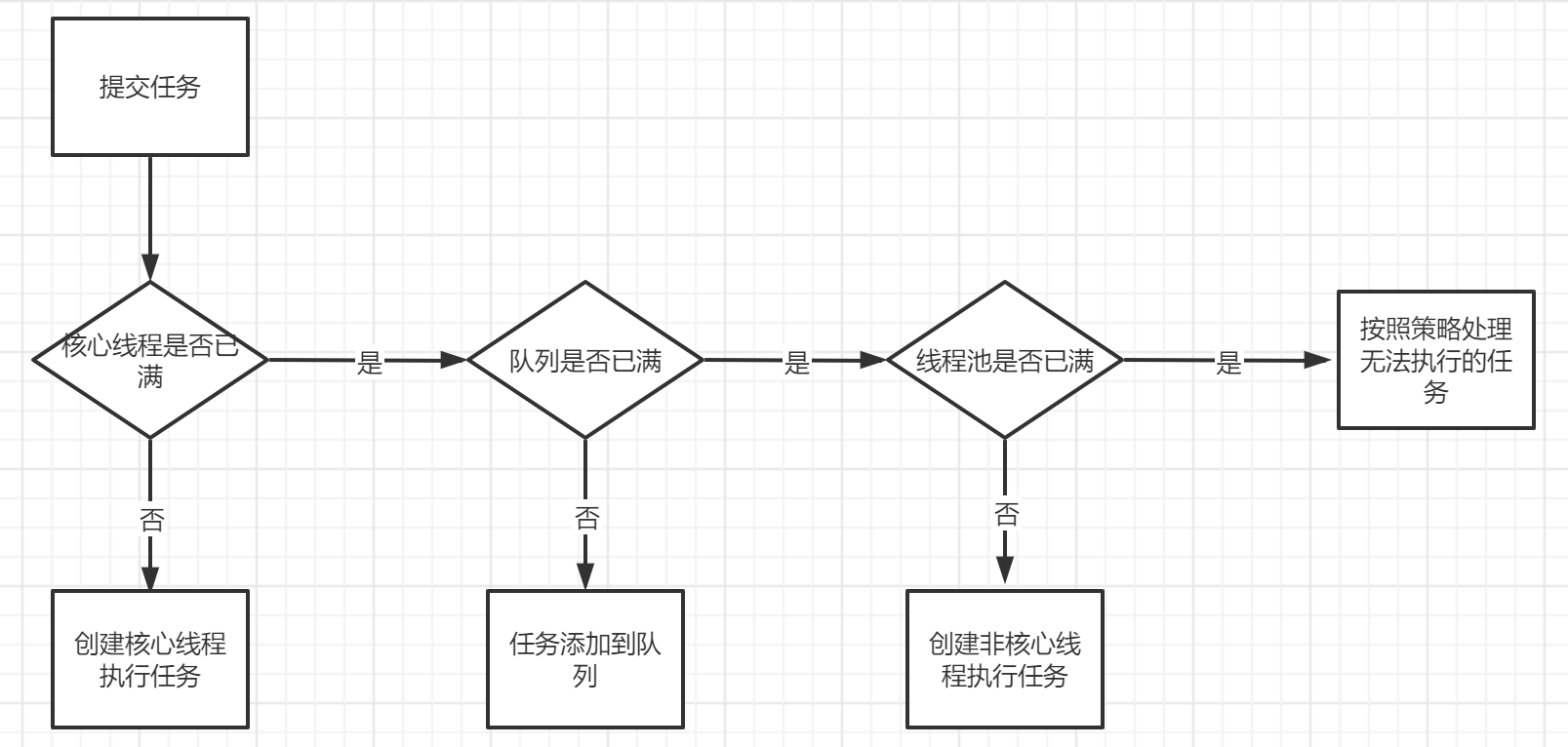手動創建線程池
在使用Executors創建線程時,阿里巴巴規范提出了
手動創建線程池,效果會更好哦。使用ThreadPoolExecutor方式創建線程池,可以規避資源耗盡風險(OOM)
ThreadPoolExecutor的構造函數
public ThreadPoolExecutor(int corePoolSize,
int maximumPoolSize,
long keepAliveTime,
TimeUnit unit,
BlockingQueue<Runnable> workQueue,
ThreadFactory threadFactory,
RejectedExecutionHandler handler) {
if (corePoolSize < 0 ||
maximumPoolSize <= 0 ||
maximumPoolSize < corePoolSize ||
keepAliveTime < 0)
throw new IllegalArgumentException();
if (workQueue == null || threadFactory == null || handler == null)
throw new NullPointerException();
this.acc = System.getSecurityManager() == null ?
null :
AccessController.getContext();
this.corePoolSize = corePoolSize;
this.maximumPoolSize = maximumPoolSize;
this.workQueue = workQueue;
this.keepAliveTime = unit.toNanos(keepAliveTime);
this.threadFactory = threadFactory;
this.handler = handler;
}
Alibaba規范警告信息
線程池不允許使用Executors去創建,而是通過ThreadPoolExecutor的方式,這樣的處理方式讓寫的同學更加明確線程池的運行規則,規避資源耗盡的風險。 說明:Executors返回的線程池對象的弊端如下:
1)FixedThreadPool和SingleThreadPool:
允許的請求隊列長度為Integer.MAX_VALUE,可能會堆積大量的請求,從而導致OOM。
2)CachedThreadPool:
允許的創建線程數量為Integer.MAX_VALUE,可能會創建大量的線程,從而導致OOM。
Positive example 1:
//org.apache.commons.lang3.concurrent.BasicThreadFactory
ScheduledExecutorService executorService = new ScheduledThreadPoolExecutor(1,
new BasicThreadFactory.Builder().namingPattern("example-schedule-pool-%d").daemon(true).build());
Positive example 2:
ThreadFactory namedThreadFactory = new ThreadFactoryBuilder()
.setNameFormat("demo-pool-%d").build();
//Common Thread Pool
ExecutorService pool = new ThreadPoolExecutor(5, 200,
0L, TimeUnit.MILLISECONDS,
new LinkedBlockingQueue<Runnable>(1024), namedThreadFactory, new ThreadPoolExecutor.AbortPolicy());
pool.execute(()-> System.out.println(Thread.currentThread().getName()));
pool.shutdown();//gracefully shutdown
Positive example 3:
<bean id="userThreadPool"
class="org.springframework.scheduling.concurrent.ThreadPoolTaskExecutor">
<property name="corePoolSize" value="10" />
<property name="maxPoolSize" value="100" />
<property name="queueCapacity" value="2000" />
<property name="threadFactory" value= threadFactory />
<property name="rejectedExecutionHandler">
<ref local="rejectedExecutionHandler" />
</property>
</bean>
//in code
userThreadPool.execute(thread);
線程執行的邏輯圖與說明
邏輯圖

邏輯說明
- 判斷核心線程數是否已滿,核心線程數大小和corePoolSize參數有關
- 若核心線程池已滿,判斷隊列是否滿,隊列是否滿和workQueue參數有關
- 若隊列已滿,判斷線程池是否已滿,線程池是否已滿和maximumPoolSize參數有關
- 若線程池已滿,則采用拒絕策略處理無法執執行的任務,拒絕策略和handler參數有關
ThreadPoolExecutor的構造方法參數說明:
- corePoolSize => 線程池核心線程數量,他來決定新的任務是創建新線程執行,還是丟到workQueue任務隊列中去
- maximumPoolSize => 線程池最大數量,這個參數會根據你使用的workQueue任務隊列的類型,決定線程池創建的最大數量
- keepAliveTime => 空閑線程存活時間,當空閑線程數量超過corePoolSize時,多余線程會在到存活時間時被銷毀
- unit => 時間單位,keepAliveTime的時間單位
- workQueue => 線程池所使用的任務隊列,它被添加到線程池中,但尚未被執行的任務;它一般分為直接提交隊列、有界任務隊列、無界任務隊列、優先任務隊列幾種
- threadFactory => 線程池創建線程使用的工廠,工廠名字等,一般用於默認即可
- handler => 線程池對拒絕任務的處理策略,當任務太多,如何拒絕任務
我們可以使用Alibaba規范來創建線程
完整代碼
package com.demos.date.thread;
import cn.hutool.core.thread.ThreadFactoryBuilder;
import java.util.concurrent.*;
public class Thread01 {
public static void main(String[] args) {
// 編寫線程的名字,一般使用默認即可,
ThreadFactory namedThreadFactory = new ThreadFactoryBuilder()
.setNamePrefix("demo-pool-%d").build();
ExecutorService pool = new ThreadPoolExecutor(2, 200,
0L, TimeUnit.MILLISECONDS,
new LinkedBlockingQueue<Runnable>(1024),namedThreadFactory, new ThreadPoolExecutor.AbortPolicy());
// 調用線程
for (int i = 0; i < 4; i++) {
pool.execute(()->{
System.out.println(Thread.currentThread().getName()+Thread.currentThread().getId());
pool.shutdown();
});
}
}
}
